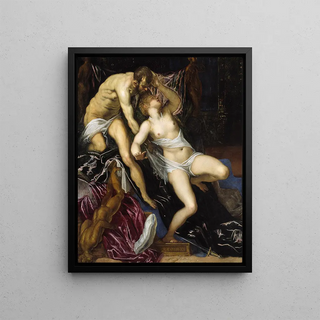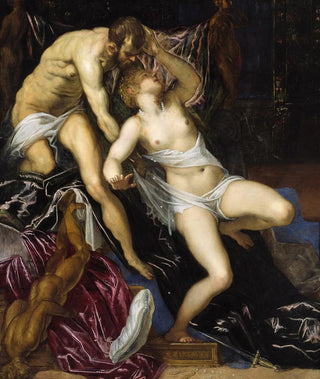Art print | Tarquin and Lucretia - Jacopo Tintoretto Source: Reproduction | Tarquin et Lucrèce - Jacopo Tintoretto


View from behind

Frame (optional)
In the fascinating world of art history, some artworks stand out for their ability to capture deep emotions and tragic stories. "Tarquin and Lucretia" by Jacopo Tintoretto is one of those iconic pieces that transcend time. This canvas, painted in the 16th century, tells a story of passion, betrayal, and sacrifice, drawn from Roman mythology. The dramatic portrayal of Lucretia, at the heart of this tragedy, evokes a psychological depth that invites viewers to reflect on universal themes of honor and virtue. The work embodies the very essence of Renaissance painting, where human emotion is highlighted with rare intensity.
Style and uniqueness of the work
Tintoretto's style is characterized by unmatched dynamism and bold use of light and shadow. In "Tarquin and Lucretia," movement is palpable, with each character seeming to be in the grip of an emotional storm. The composition is carefully orchestrated, with diagonal lines guiding the viewer’s gaze across the scene, creating dramatic tension. Rich colors and striking contrasts enhance the visual impact of the artwork, while the meticulous details of faces and draperies add an almost tactile dimension to the painting. Tintoretto manages to blend realism with a certain idealization, making the figures both human and emblematic. This unique approach allows the work to resonate with a surprising modernity, touching sensitive chords that continue to move contemporary art enthusiasts.
The artist and his influence
Jacopo Tintoretto, born in 1518 in Venice, is often regarded as one of the masters of Venetian painting. His work is marked by an incessant quest for novelty and a desire to transcend the conventions of his time. Influenced by Michelangelo and Titian, Tintoretto developed a personal style that combines expressive power with virtuoso technique. His ability to capture moments of intense emotion and translate them onto canvas has had a

Matte finish

View from behind

Frame (optional)
In the fascinating world of art history, some artworks stand out for their ability to capture deep emotions and tragic stories. "Tarquin and Lucretia" by Jacopo Tintoretto is one of those iconic pieces that transcend time. This canvas, painted in the 16th century, tells a story of passion, betrayal, and sacrifice, drawn from Roman mythology. The dramatic portrayal of Lucretia, at the heart of this tragedy, evokes a psychological depth that invites viewers to reflect on universal themes of honor and virtue. The work embodies the very essence of Renaissance painting, where human emotion is highlighted with rare intensity.
Style and uniqueness of the work
Tintoretto's style is characterized by unmatched dynamism and bold use of light and shadow. In "Tarquin and Lucretia," movement is palpable, with each character seeming to be in the grip of an emotional storm. The composition is carefully orchestrated, with diagonal lines guiding the viewer’s gaze across the scene, creating dramatic tension. Rich colors and striking contrasts enhance the visual impact of the artwork, while the meticulous details of faces and draperies add an almost tactile dimension to the painting. Tintoretto manages to blend realism with a certain idealization, making the figures both human and emblematic. This unique approach allows the work to resonate with a surprising modernity, touching sensitive chords that continue to move contemporary art enthusiasts.
The artist and his influence
Jacopo Tintoretto, born in 1518 in Venice, is often regarded as one of the masters of Venetian painting. His work is marked by an incessant quest for novelty and a desire to transcend the conventions of his time. Influenced by Michelangelo and Titian, Tintoretto developed a personal style that combines expressive power with virtuoso technique. His ability to capture moments of intense emotion and translate them onto canvas has had a






